A proper survival backpack is among the most essential items of your gear. Whether you are keen on hiking or preparing for a survival trip, you can put all your tools, gadgets, and your sleeping bag into the survival rucksack. In case of the rain in the woods, a waterproof heavy-weight but with comfortable shoulder straps will be beyond matters of prise.
Nobody wants to think that the world outside can become dangerous in the blink of an eye. It has never been a safe place and will never be one, especially in a world of advanced technologies and people, nuclear bombs, and climate changes that are likely to trigger an environmental catastrophe.
Has there been a period in our history without something that would disturb our peaceful existence? Earthquakes, wildfire, floods, terrorist acts, wars, what not – it is impossible to predict neither nature nor human intentions. Whether you are an experienced survivalist or not, it’s better to prepare yourself for the worst. Rather than find yourself in danger without knowing what to do.
What will be the first thing on your list of survival things? Of course, a good survival backpack! Then you will put everything you need (gear, food, etc.) into it. It’s better to have proper gear at hand than to waste your time on making tools from things found in nature. But for those who don’t remember how to handle bones and sticks and don’t know what things they can build out of them, a Bushcraft survival backpack is the best option.
Not all backpacks will do when you prepare for a risky and dangerous trip. Some of them can prove to be not really durable and fail to “back you up,” if you know what I mean. Backpacks like Jan Sport will not do for a survival mission. Choose a more upgraded high-quality version that can withstand all possible trials — a tactical backpack. What makes it so great? It’s simple. A tactical backpack can become your best friend not only in a survival situation but in your regular life as well. Its high durability, water resistance, weight – these features make a tactical backpack useful when carrying valuable things to work (for instance, a laptop) or hiking.
TOP Best 5 Most Durable And Reliable Backpack Options
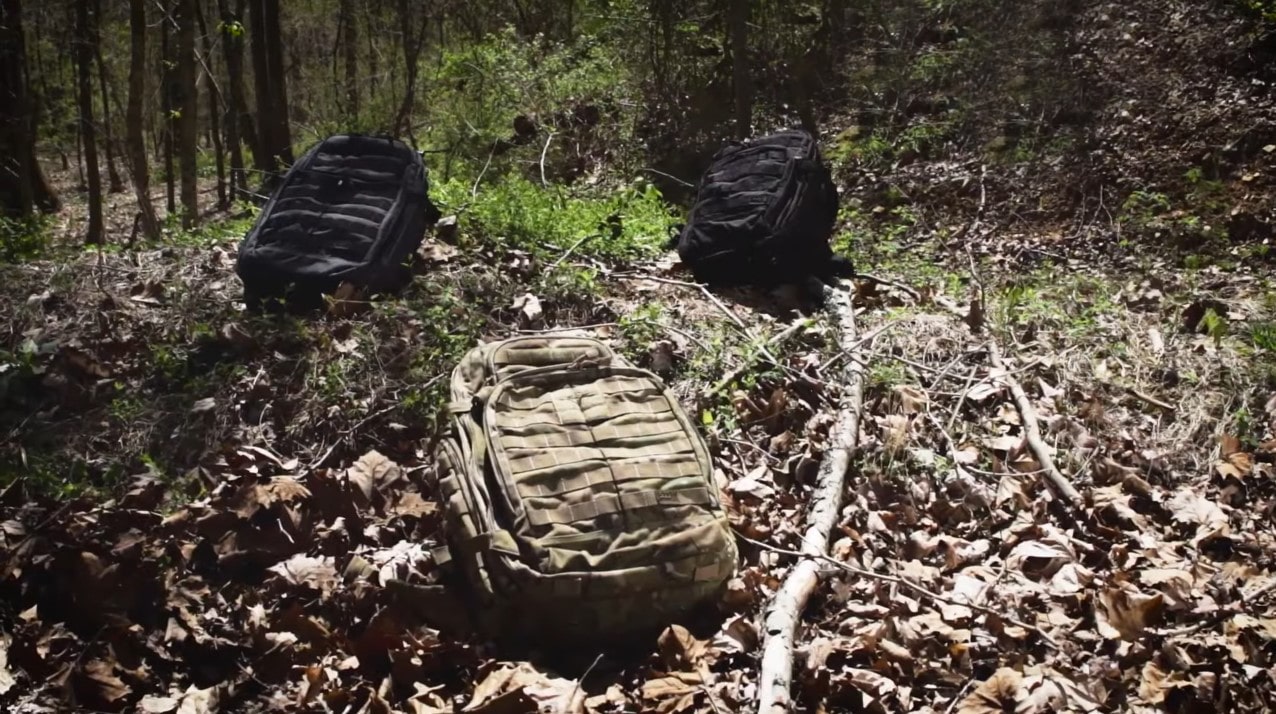
If you find yourself ready for an unpredictable situation, you can start choosing a perfect survival backpack. You’re lucky to get here – we’ve picked up the best survival backpacks you can find on the market today. Each of them has a set of characteristics mentioned above. There are both affordable and expensive backpacks. We’ve tried to make a list interesting for every type of survivalist.
5.11 RUSH 12/24/72 Bag

Do you know what backpack is the best-seller? Sure, it is the family of 5.11 Tactical Rush backpacks, which have enough storage space, including two front pockets and two main compartments with additional sections (including a special storage compartment for water) to put the gear you need. The backpacks of this series look pretty much the same. The difference is in the volume. Rush 12 bag has 21 liters total capacity. This military tactical backpack meant for a 12-hour journey has lots of room and compartments for your gear. Rush 12, like any other backpack of this family, makes it possible for the owner to use the MOLLE system.
It’s not difficult to guess how much food and gear supplies the 37-liter Rush 24 and the 55L Rush 72 can include and how many hours a survivalist can be on the move.
The 5.11 Tactical Rush family has a high-quality retrieval system and high-strength shoulder straps, a hydration pocket, a height adjuster, a compartment for fragile items, and a sternum strap.
The price is rather high, but it is worth purchasing as the backpack is also water-resistant, making it perfect for any outdoor expedition.
Condor 3-Day Assualt Backpack

EVATAC Combat Bag

The EVATAC Combat backpack is a product made by geniuses. The backpack that even the creator of one of the most interesting and useful survival articles owns himself and highly recommends.
Let’s see what makes it so durable. First of all, it is made of 600D polyester. This material makes it able to withstand the worst weather conditions (it is also water-resistant) and other trials. Unlike survival backpacks made from cheap fabric, 600D polyester constructing this survival backpack will not let you down even after two years of survival expeditions.
The quality of zippers and clips in this survival backpack is super high! You won’t have to mend them during your outdoor missions. A chest strap, padded shoulder straps…those who seek comfort are going to want this!
10 water-resistant compartments will protect and organize your gear. You can even take a sensitive digital device. There is a compartment to keep it, too!
Check out the most recent backpack price, which combines all features a good backpack should have.
Reebow Gear Tactical Military Backpack
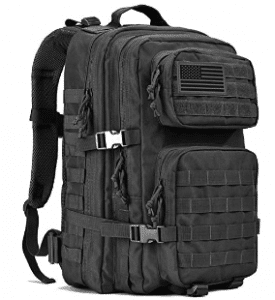
Many owners have noticed that shoulder straps often fall off, which makes the backpack uncomfortable to wear. But, some of them have found a solution! The backpack has a hip strap which can prevent staps from falling off. However, they claim that it is not very supportive either.
Still, being water-resistant and having the MOLLE webbing and the hydration system, it remains one of the best survival backpacks you can find for this price.
Pre-Loaded Survival Backpack
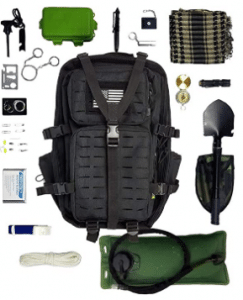
The tactical kit includes all the basic tools you will need in an emergency or during a tiresome journey: a hydration bladder with a hose, a paracord, a shovel, and many other necessary tools you can put into a 40L backpack and carry up to 3 days in the wilderness.
Its size capacity, the molle lining, gear package, durable zippers and clips, and reasonable price satisfy many customers.
Check out our survivalist’s must-have list and click the link to learn more details about each essential item.
What to Include in a Backpack?
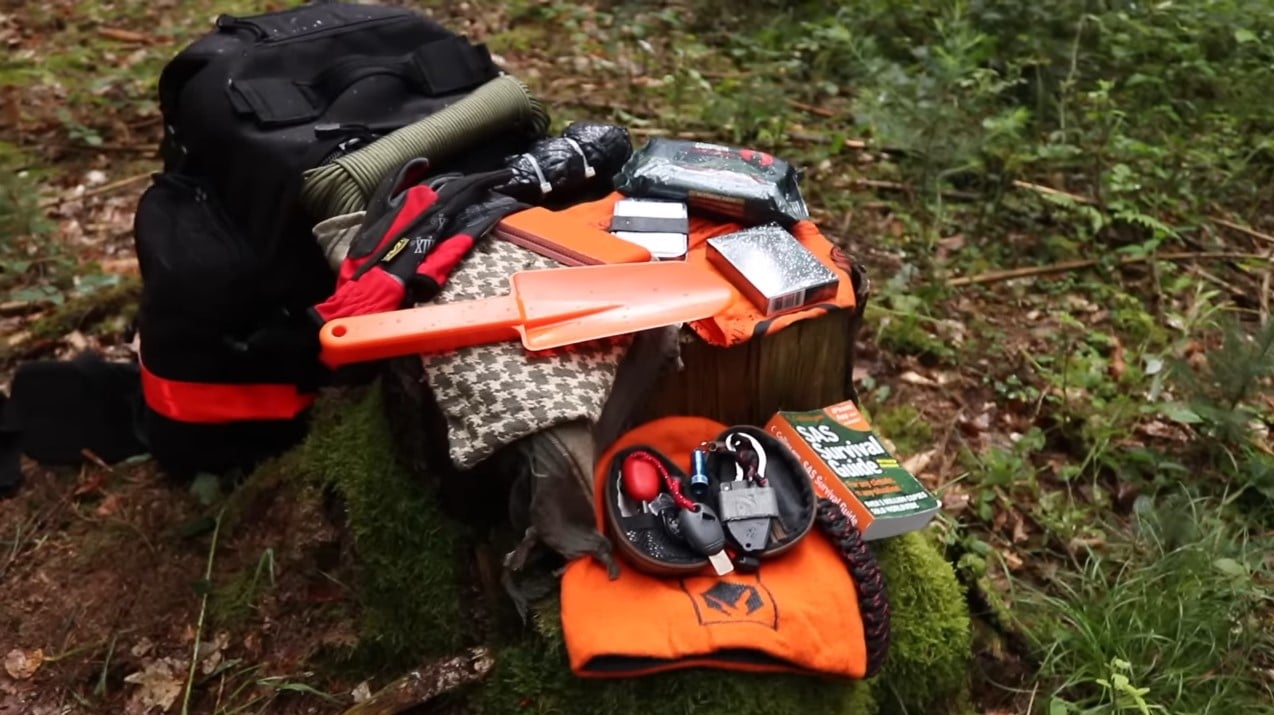
- Water – you need to have at least 1 gallon of water for a three-day period. That’s where a backpack comes into before everything else!
- Food – what if you don’t manage to find anything edible? There should a place to keep canned food!
- Clothes – always take a minimum number of clothes items to feel a bit more comfortable in an unfriendly environment.
- A Ferro rod – it saves a good deal of time when you try to create a hot spark.
- First aid kit – even if it consists only of gauze bandage, is it possible to carry it without a backpack?
- Tools – things like a good survival knife, a paracord – the first necessary items that come to mind – are not easy to make when your survival is at risk. So, you already know where to keep your gear and get easy access to it.
- A lantern – an essential thing to have when you wander in the darkness.
- Personal documents – you need to take something that will prove your identity.
- Self-defense weapon – have a gun or knife at hand in case a situation goes out of control.
- A gas mask – this item will help you breathe and will prevent you from dying in case of an ecological disaster.
You can include any other essentials you need (a sleeping bag, cups, etc.), but make sure that your survival backpack has a comfortable weight.
We’ve mentioned these things just to refresh your memory and to give you a better understanding of the purposes a backpack serves. But, actually, we’ve touched upon this topic many times before. For more detailed lists of survival gear, you can check out the lists for the following survival bag types:
You can also read a separate article on all kinds of survival gear you need for an emergency. You can be sure that this checklist will not let you forget something. It covers all things you may need – from water to weapons.
How to Choose a Good Survival Backpack?
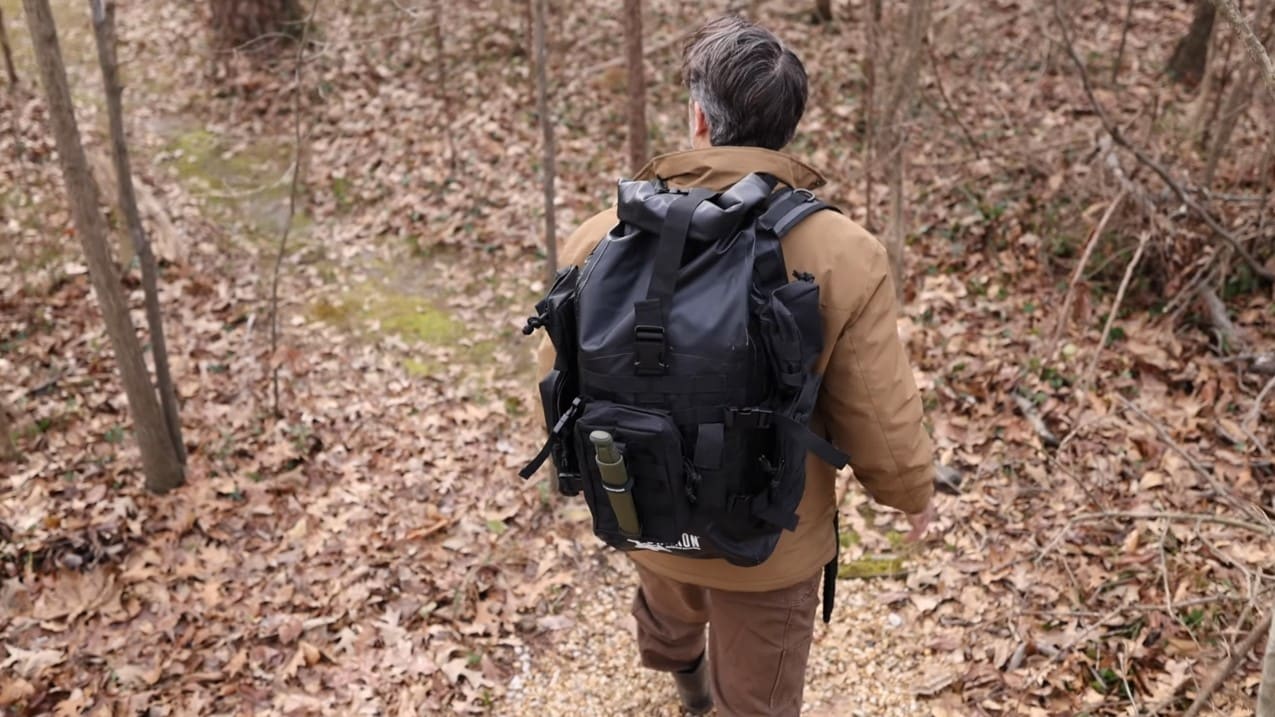
We’re glad you’re here. We ensure that there will be no paralysis by analysis. The first thing you need to do is decide what is an ideal backpack for you, what features it should have, etc. So, when scrolling down numerous survival backpacks, you can ignore those that do not fulfill your requirements.
All survival backpacks on the market are pretty much the same in shape and color, so read carefully about the key characteristics of backpacks you liked to see if it is has everything you need.
Below is the list of the most important features to consider when you decide to choose a backpack.
High Durability Gear
A tactical backpack should be as durable as possible. It is probably the most important criterion as, in the wilderness, there is no time and extra energy for mending a torn backpack. If you don’t have a sewing kit in your backpack, it may put your life at risk. Choose a backpack with high-quality fabric, such as Cordura (extremely durable and resistant to abrasion). It can make your tactical backpack a bit heavier, but you will not regret your choice after your backpack withstands the worst conditions. Do not buy survival backpacks made of cheap and thin nylon. The main advantage of Cordura is its durability and waterproofness – features you need to put before weight. Water-resistant material is a must when the weather is rainy.
This criterion also includes great-strength zippers. Heavy-duty YYK zippers are those that are supposed to be on raincoats and survival backpacks. The shiny polyurethane coating on the outside surface makes it water-resistant, so it ensures the safety of your tools. The closure system on the top side is similar to a ziplock back as it comes together in almost bonds perfectly. Every skilled survivalist knows that it is No. 1 on the market and has very few negative reviews. Perfect option!
When choosing a backpack, you should pay special attention to the stitching system – a good backpack with double-stitching will be more reliable and durable. Seamed with a serger, a backpack may come apart at the seams and spoil your trip. If you don’t have a needle and thread, all your preparations can go to the dogs.
Comfortable Shoulder Straps
To achieve the best results and success, you need to work hard. Almost all the most interesting things in life require your readiness to challenge. Surviving is anything but comfortable, but it can give valuable experience and change your views completely. So, if it’s possible to make something comfortable, it should be your backpack in the first place.
A “comfortable” backpack means that it is easy to carry, and it doesn’t cause back or shoulders discomfort.
Choosing a particular backpack, try it on – if you don’t feel discomfort, it is worth choosing this model. It is an essential criterion because you will have to carry your backpack on your shoulders for a long time!
A high-quality backpack normally has strong and wide padded shoulder straps – they will allow you to distribute the load on the spine evenly, and you won’t get tired even if you fill your backpack with lots of different tools so that it has a considerable weight. For an average person, shoulder straps’ ideal width narrowing to the lower part is six-seven centimeters.
The sternum type’s main purpose is to keep the straps of the backpack at a certain distance from one another, preventing them from sliding down the shoulders and more effectively fix the backpack on your back. However, if you adjust your backpack to your height, you can do without them. Plus, it constricts the chest when you breathe. So, it’s up to you to decide!
It is also essential to have a hip strap (or a hip belt). They can transfer up to 50% of the backpack’s load from your shoulders and back and to your hips and prevents the backpack from flopping on your back. Make sure that you can strongly tighten the staps even when wearing a backpack over one T-shirt. A hip belt should be easy to adjust to your size and weight. Today almost all good survival backpacks have hip straps. Please keep in mind that they are the most frequently broken element of the backpack so that sometimes people change them several times within a year. And if it breaks down during your journey, you should have one or two extra ones in your backpack. If your backpack is cumbersome, these straps will make your journey a bit more comfortable. For lighter survival backpacks, they can be useless.
By the way, manufacturers are more caring when they deal with women’s backpacks. They tend to make them with contoured straps, ensuring more comfort, and preventing their muscles from fatigue. Such survival backpacks often turn out to be more comfortable to wear.
The Right Weight & Size
Choosing the proper size of your survival backpack is a real challenge. Your backpack should not be too big, but it should have enough room for all your tools. Filter your choice when deciding to pack your tactical backpack. Think twice when you want to put a couple of books to read in a cozy environment or a survival hammock. If it’s a three-day trip, do you need all these things at all? Just in case, the answer is no! Sometimes you can replace three things with one – instead of taking several blankets and a hammock, you can put only a sleeping bag into your backpack.
Keep your backpack light. It will not only prevent you from getting tired faster than you reach a certain destination but will allow you to get through narrow nooks and passages as well.
A backpack should keep you on track – you should not leg behind. Is carrying a 100 Ibs backpack reasonable? After a few days of having it on your back, you will want to throw it down a cliff.
“This backpack is a nightmare! My back and shoulders hurt so much!” – is it what you want to think about when a fight-or-flight situation happens to you?
Many survivalists claim that the perfect liter capacity of a survival backpack is 30-40 liters. It will be a good and undisturbing company even if your hiking trip takes more than two days. You can take things like extra food, clothing, etc. Take care of your back; do not choose massive backpacks.
Enough Compartments and Pockets
Survival backpacks that are empty inside are not worth purchasing. Are there still any, I wonder? Your backpack should have lots of storage compartments and exterior pockets to organize your gear most effectively. Without them, there will be a mess inside your backpack. These simple elements can help you get easy access to your belongings immediately – it is very convenient both during everyday trips, hiking, or traveling.
You can keep a water bottle, phone, or knife in exterior (or side) pockets. Those are things that you may need every minute. Don’t conceal them in the internal compartments. However, remember that exterior items are the most accessible ones, so avoid keeping high value or those you don’t want other people to see in external pockets.
Wait…There is one tiny problem. The more pockets you have, the heavier your backpack is. So, your back won’t thank you for the additional bag weight you can do without. Your backpack should include the basic set of compartments: one or two big compartments to keep your freeze-dried food, clothing, medical supplies, a survival tent, and other gear items necessary for camping; a few pockets for items of a smaller size, and several tiny compartments for things you can easily lose. Keep small items somewhere near your hands in external pockets or side pockets to access them. Your survival backpack may also have a sleeping bag compartment.
One of the best and well-known retrieval systems is MOLLE. Every military survival backpack has it. For those who don’t, the MOLLE system stands for “Modular Lightweight Load-Carrying Equipment.” A backpack with the MOLLE system (also called MOLLE webbing) can have lots of straps outside (on the side pockets and the top). You can attach your MOLLE pouch to your backpack to move your accessories around and have easy access to it. Watch this video if you want to know more about this system and enhance storage capacity.
Water Bottles. Bye!
Water bottles are not convenient for long journeys in which you’d better save every bit of your energy.
Experienced travelers have come up with a better idea – the hydration system!
How does it work? You can drink water from a soft container (or hydration bladder) through a hose placed directly in your backpack. It allows you to drink at any time without stopping and taking off your backpack. Quench your thirst right on the go! We recommend putting your hydration pocket into the main compartment of your survival backpack to distribute weight effectively and achieve balance. Do NOT keep your knife or any other sharp gear item in the same compartment with the bladder, as you will have to think of other ways to get clear water. Most of them have a volume of 2-4 liters. A hose provides easy access to water on the go.
There are two main types of this system: the one with a lid and a sealed clip. The former is difficult to fill with liquid without taking them out of the backpack, and it is difficult to get water by drowning it in the spring. You can easily put it under the stream of the spring; the latter type makes it possible to sink the system in a reservoir and quickly fill it with liquid.
It’s more difficult to keep it clean than a regular bottle, but it’s the best solution for those who want to save more time and energy.
XS Or XXL Bag?
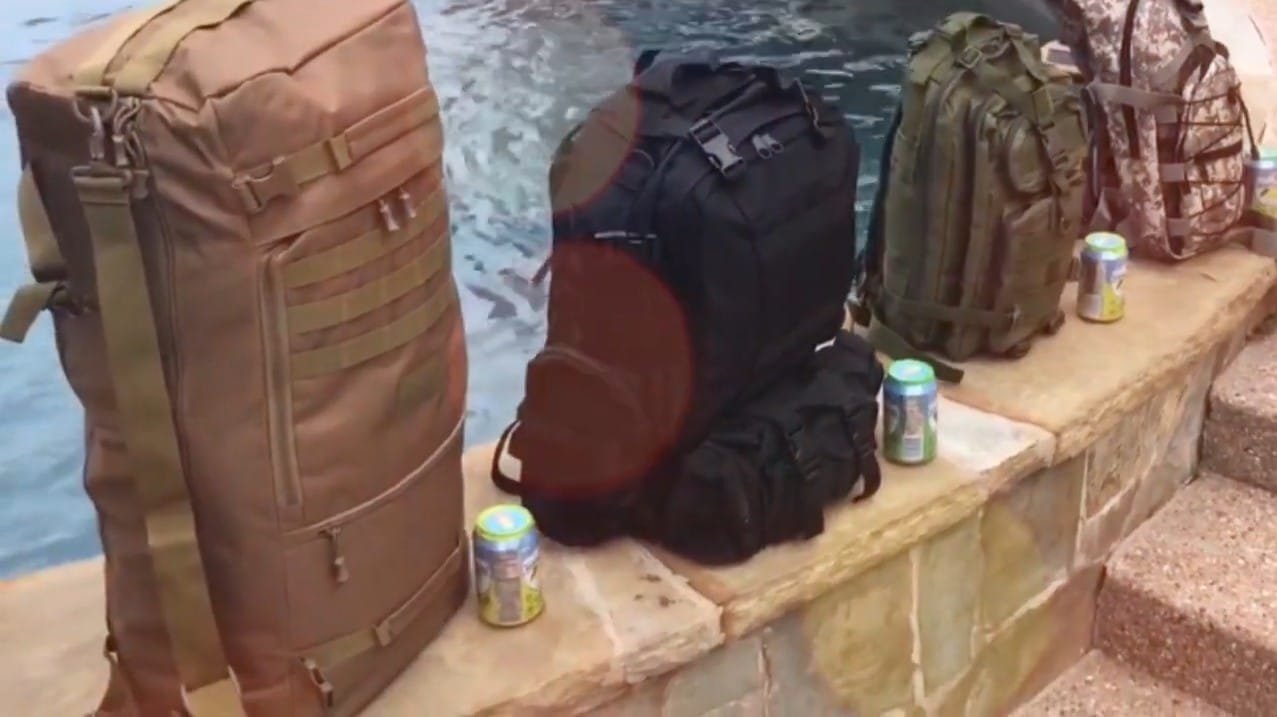
To choose the proper size, you need to measure the torso’s length and the hips’ width. Let someone do it for you. Start at the seventh cervical vertebra to the iliac crest of the small pelvis. Medical terms, bruhh…In simple terms, start at the base of your neck to the top of your hips. Follow the curve of the spine. Your measurement tool should not be stretched like a string.
If your backpack has a hip belt, ensure that you have 7-15 cm space between the straps’ two ends.
Once you’ve measured the length of your back and found out what size you need, you can find a backpack that will fit you perfectly.
Best Survival Backpack Summary
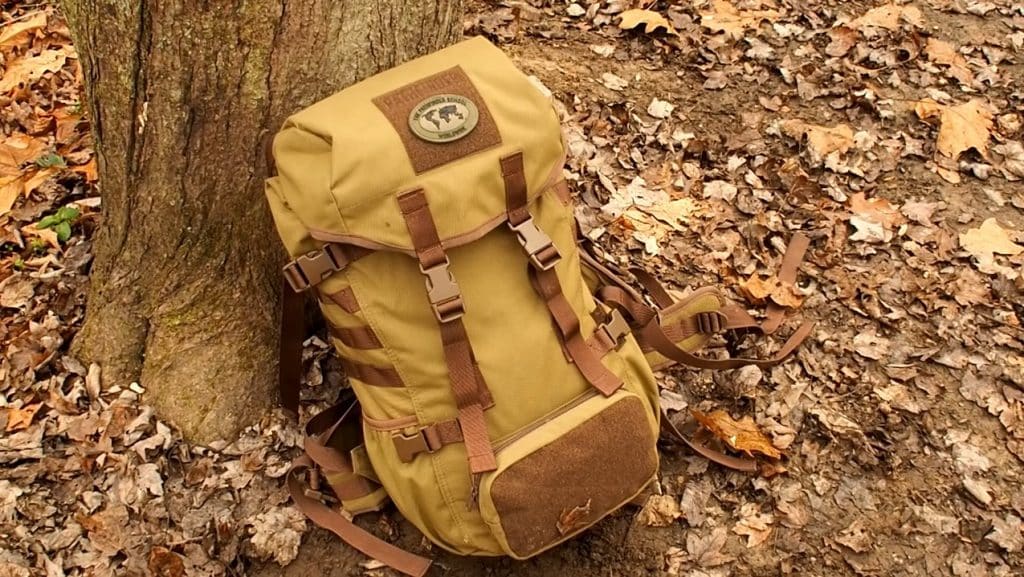
We hope you’ve got many insights from this article and learned how to cope with this uneasy task. Get prepared properly and save as much time as possible!
Frequently Asked Questions – FAQ
What is the best survival backpack?
In this article, we’ve provided a list of the best survival backpacks which have all features any good backpack should have: lots of storage space to keep your gear (or proper liter capacity), compartment division, heavy-duty zippers, comfortable shoulder straps (along with a chest strap and a hip strap), the MOLLE system, double-stitching, waterproofness, hydration system, etc. We’ve selected those survival backpacks that got the most positive reviews from different people. We’ve also provided detailed guidelines on how to choose one.
What should be in a survival backpack?
Your survival backpack should have everything that will help you to survive. The basic tools include all the items that a person might need to survive a catastrophe: medical kit, food supplies, items to start a fire and build a shelter, several clothing items, personal hygiene items, self-defense and hunting tools, and many other survival essentials.
What are the top 10 survival items?
In this article, we dwell upon this issue as well. There are lots of items you will need in the wilderness. Basically, your survival kit should include water supplies and a water filter, a medical kit, a Ferro rod to start a fire, clothes to change when those you’re wearing get soaked, weapons for self-defense and hunting, frozen food, a lantern to find a way out of the darkness, some document that will show your identity, a gas mask (if an ecological disaster happens). Check out the complete must-have lists and decide which things you need. Do not forget to put all these things into a high-quality survival backpack.
What is a good waterproof backpack?
All the survival backpacks we’ve included in the list above are water-resistant. Constructed from good materials, they ensure the protection of your gear in any weather conditions. Remember that a survival backpack should have water-resistant and heavy-duty zippers as well. Read reviews people write on the websites selling survival backpacks and check if the backpack you want to buy is really water-resistant.


